The best form of protection for armored vehicles
Companies Lockheed Martin, Northrop Grumman and the Armored Research and Development Center are working together on the initial integration of the modular active defense system into the M1 Abrams tank of the US Army
Protection technologies for combat vehicles are being developed in accordance with the requirements of the military for active protection systems and a reduction in the total mass with the aim of gradually avoiding the common practice of installing heavy armor plates.
Not so long ago, the crews of armored vehicles depended only on the strength of the armor surrounding them, but as modern platforms become increasingly digital - various sensory and network capabilities are increasingly used - the military can now receive an additional level of protection, which could not be achieved with armor alone.
Effects of the agreement
For the ground forces, the traditional idea of protecting their vehicles was to ensure sufficient reservation levels (passive and dynamic) that could withstand the effects of kinetic-type projectiles, a blast wave, and artillery shell fragments. For NATO and partner countries, this meant meeting the highest standards of protection, often referred to as the 4569 Standardization Agreement (STANAG).
This view was reinforced by the conviction that if the car had obvious vulnerabilities to certain attacks — as is the case with several types of armored vehicles in Iraq and Afghanistan that continually ran into improvised explosive devices (IEDs) —– then the solution is to add reservations. level of protection. For example, during the Iraqi conflict, the booking of Hummer armored vehicles (HMMWV) of the US Army was significantly strengthened in an attempt to protect crews from deadly roadside mines.
Armored car "Hummer" with enhanced armor
Recent wars in the Middle East, including Iraq, Syria and Yemen, have also made it necessary to pay special attention to the threat posed by a new generation of ATGMs, the combat units of which are capable of breaking through the armor of even the most modern main combat tanks (MBT).
Indeed, the experience gained in recent conflicts has forced the army to seriously strengthen the armor protection of their vehicles. However, this entailed an increase in the total mass of machines beyond the limits of reasonable - tanks have now reached the mark of 70 tons - which in turn affected the mobility of the machines (the platforms themselves, as well as the corresponding equipment) and component wear.
Knowledge is power
While reactive and passive armor retains its key role in protecting people in the car, and is likely to retain it for a long time in the future, many armies around the world are increasingly paying attention to alternative defenses that sensors use. (including day / night cameras, laser and ultraviolet radiation warning systems, Doppler radars and acoustic detectors), electronic architecture, advanced countermeasures and networking capabilities that help exchange and information about potentially dangerous threats with the rest of the combatants.
The emphasis today is not only on protecting the crew of the vehicle at the moment when the attack has already begun, but also on preventive measures that could warn the crew and other military personnel who are not exposed to immediate danger before its commencement. This would allow the crew of the vehicle to properly plan and execute either a tactical retreat or a counterattack on the enemy’s position.
An example of how such a concept unfolds in the real world is the Scorpion program of the French army. As part of this ambitious program, the army will initially deploy two new machines — the Griffon 6x6 and the Jaguar 6x6 — along with the recently developed Contact-based programmable radio station Contact and the Scorpion Combat Information System (SICS) battle management system, which will greatly enhance operational management capabilities.
The Griffon machine currently undergoing tests uses an electronic architecture that allows data from several sensors to be combined into a single information flow and presented to the commanders of the machines. Integrated sensors include the Thales Antares Optoelectronic Station, which monitors the environment to increase levels of security and situational awareness, and also warns of laser irradiation.
“You have an overview of the 360 ° terrain on one screen ... You can detect the fact that the enemy is pointing the laser at your machine, the device determines the laser signature, what kind of enemy, and from what direction the beam is directed. And in joint combat, you can pass on this information and determine the best way to destroy the target, ”explained Sebastien Renard, director of the Scorpion program at Thales.
Information collected by Antares about the possible location of the enemy can then be transferred to other units and commanders using SICS. The station may also determine the launch of a missile from an anti-tank complex, although the French army has not yet been contracted for this function. Another sensor installed on the Griffon armored vehicle is the Metravib PILAR V shot detection system, which, like Antares, will show enemy positions for the crew and its units.
Countermeasures
Along with improved detection quality, increased digitization provides more effective deployment of countermeasures. Traditional systems are smoke grenades, fired from launchers installed along the perimeter of the hull and tower, at a time that the commander considers the most appropriate. Currently, the industry offers systems in which the manual deployment process of human countermeasures is supplemented or even in some cases already replaced by an automatic one. Lacroix, a well-known manufacturer of optical-electronic suppression systems for armored vehicles, including grenades with multispectral compounds, is also considering the possibility of integrating intelligent functions, for example, by adding warning systems.
“We have upgraded the system and now it can interact with the laser irradiation warning system,” said a Lacroix representative. “This system is capable of warning about the attack of means of destruction with laser guidance of all types, for example, laser-guided missiles, as well as laser designators.”
Information from the sensor system is then transmitted to the control unit, which automatically issues a signal to launch grenades in the direction of the threat. Lacroix’s Galix complexes with laser warning systems have already been deployed in an unnamed country in the Middle East.
These features may well be added to existing vehicles in order to increase the levels of survivability and crew protection. In Poland, for example, the local industry proposes upgrading the protection of T-72 tanks and the deeply modernized PT-91 tank (based on the licensed version of the Soviet T-72М1). It can include the 3 generation dynamic protection system and lattice armor, as well as the Obra-3 laser warning system (pictured below) from the Polish company RSO and a set of all-round cameras.
A representative of Bumar-Labedy, a Polish company in charge of upgrading, said that Obra-3 sensors would be connected to the jamming system in order to make the most effective use of smoke and masking compounds.
The main concern, when it comes to adding additional sensors and active protection systems, is in order to properly integrate them into the existing design and not have a negative impact on the capabilities of the machine, especially the existing on-board electronics. One more difficult task is not to go beyond the weight and size and energy-consuming restrictions.
To this end, the British Ministry of Defense and the Laboratory for Defense Science and Technology (DSTL) launched the Icarus program, which could help determine the requirements for the machine architecture, in particular for the integration of active protection complexes (KAZ) and optical-electronic countermeasure complexes (CEP). These active protection systems (SAZ) are becoming increasingly popular, including China, Israel and Russia.
At DSEI, which took place in September in London, it was announced that Leonardo will lead the Icarus Technology Demonstrator Program (TDP) industry group, which will develop ways to integrate low-cost “best” technologies for active protection systems. Part of the Icarus program will be the demonstration and evaluation of the work of a prototype during the shelling of its military means.
“It is very important that we approach this process in a methodical and systematic way,” said Crispian Beatty, lead engineer at Leonardo Land & Naval Defense Electronics. - Within the framework of the program, our approach to existing systems will be implemented, which will allow us to develop a kind of standard for layout and integration solutions. Everything we do is based on the best design solutions. "
Indeed, the main goal of the Icarus TDP program is to create a modular integrated electronic architecture of the MIPSEA (Modular Integrated Protection System Electronic Architecture) protection systems, which will allow "selecting, integrating and deploying the necessary sensors and actuators of the AES to neutralize a variety of existing and future threats."
Beatty explained that the TDP program will include research in 14 specific areas that cover “all colors, sizes and shapes of the program”. He added that the demonstration may take place at the end of this decade, but the type of machine is not determined due to the nature of the program. “The whole point is that it is modular and universal, and this is not by accident,” said Beatty. “We have to be sure that the components of the target system, the objects of deep integration into the machine, are scalable and modular.”
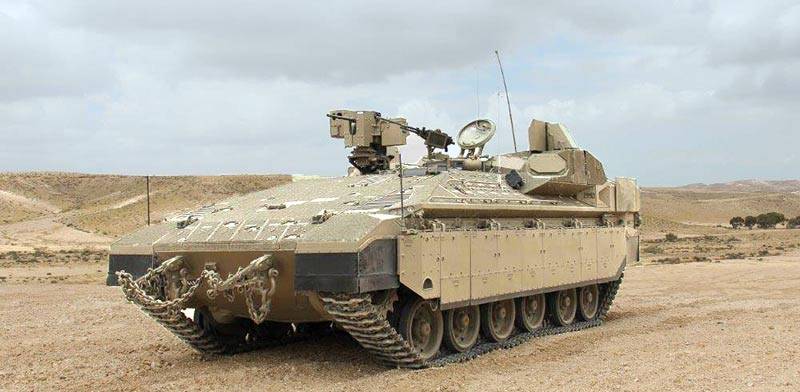
Rafael's KAZ Trophy should be installed on all Namer Israeli Army heavy armored personnel carriers
Modular projects
In 2016, the British DSTL laboratory also issued a contract to Xineyq for $ 9 million for Qinetiq SAZ for armored vehicles. In accordance with the three-year contract, known as the Medusa Technical Assessment Program, a joint SAZ assessment will be organized. Special attention will be paid to the multifunctional active protection system MUSS (multifunctional self-protection system) of the German company Hensoldt and how it can be integrated into platforms such as the Challenger 9,5 MBT.
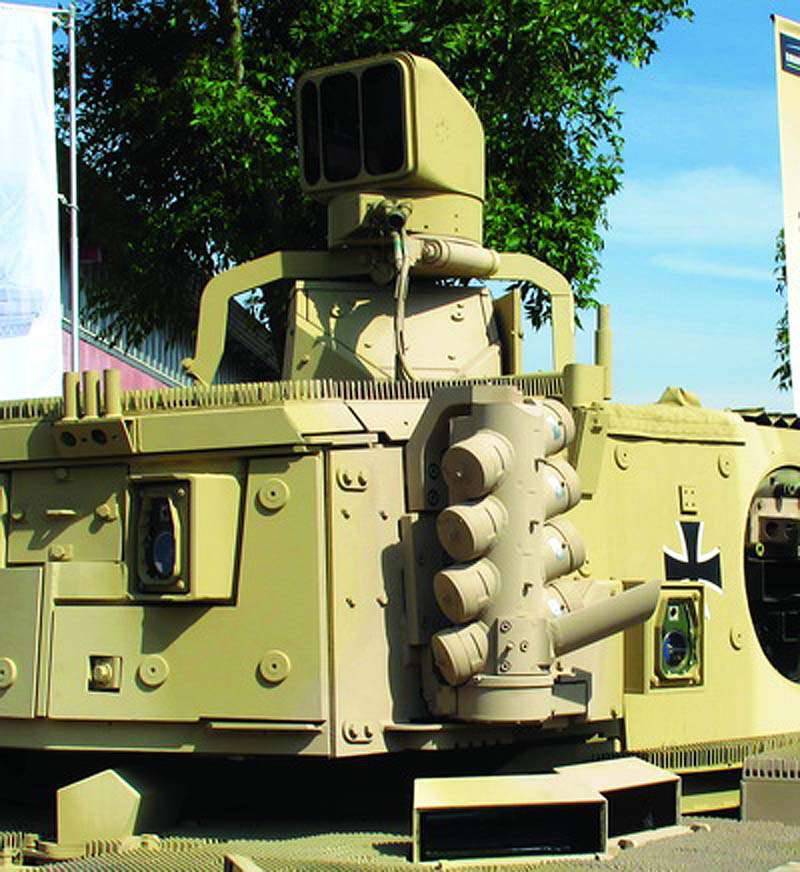
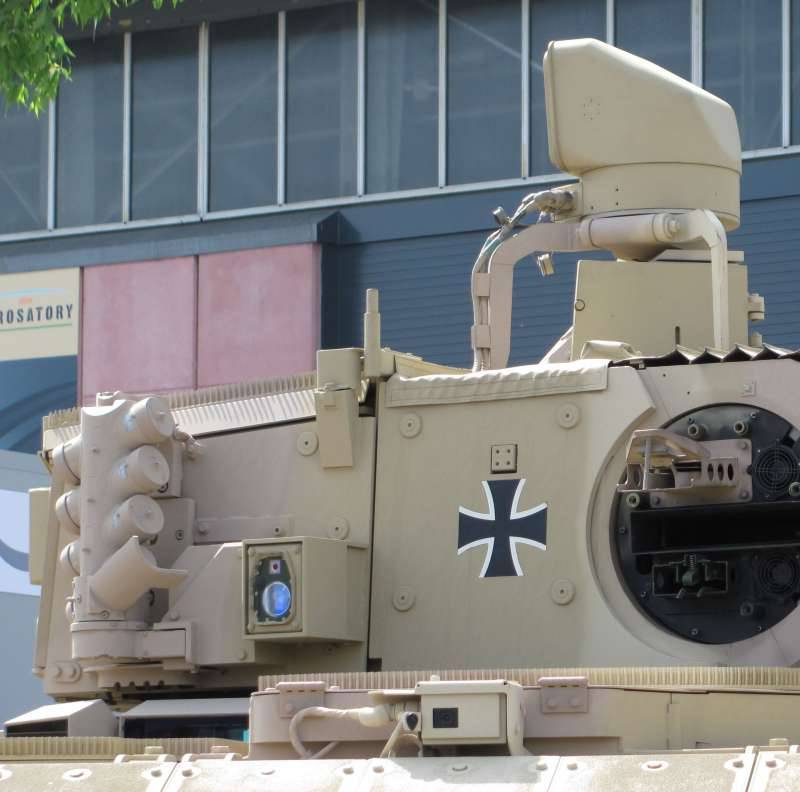
A close-up of the three components of the Muss system developed by Airbus D&S: an infrared silencer at the top, sensor blocks on the sides of the tower and a grenade launcher
MUSS, currently deployed in the German army, is a COEP, which can effectively suppress the homing head of modern missiles or put smoke or aerosol curtains.
Works similar to those conducted by the British under the Medusa Program are carried out in the American Army. There, this program is abbreviated MAPS (Modular Active Protection System - modular SAZ). The work is led by the Armored Research and Development Center (TARDEC) together with the Research Development Command (RDECOM).
A statement by the US Army states that "MAPS work is the army's basic strategy for SAZ, which aims to remove barriers associated with deploying such a system, by introducing a modular and secure design that will lay the foundation for adaptable capabilities that can be integrated into any platform."
The army announced in August that the initial general MAPS scheme had been released. The scheme is aimed at standardization of development and the possibility of modernization of the SAZ, as well as the development of subsystem technologies used in ground machines.
In April, 2016, RDECOM conducted the first physical tests of SAZ. According to the army, the demonstration of the work of CEP allowed the developers of the program “finally to reconcile the software and systems”. The companies Lockheed Martin, Northrop Grumman and TARDEC worked together to complete the initial integration into the M1 Abrams tank for which the Lockheed open-architecture processor and the sensors and actuators from Northrop Grumman were used.
A TARDEC spokesman said that “we await the release of the first version of this SAZ, which will include everything that has been achieved since the start of the theoretical research and the release of the beta version of SAZ in February 2016. Carrying out integration work in the last 16 months, we laid the foundation, used three different approaches to SAZ work and showed, using the modular principle, the first continuous sequence of destruction, from issuing a signal to neutralizing the threat. ”
The advantage of using components of SAZ, which are based on a modular architecture, is that they can be developed independently and quickly integrated, which will save time and money. This can also help ensure that the army does not become hostage to one supplier, there will be more competing players in this sector and, as a result, more innovative ideas.
Along with this long-term, forward-looking SAZ program, the US Army is also studying ready-made systems on different types of combat vehicles. This procedure includes the quick installation of the SAZ on the M1 Abrams tank, the Bradley BMP and the Stryker 8xXNNX wheeled armored personnel carrier. It is reported that the army is "very close" to the decision to deploy SAZ on the machines of these classes after conducting a series of tests.
The BME CV90 from BAE Systems with two integrated Iron Fist launchers developed by IMI Systems was shown at DSEI 2017
Valuable protection
Perhaps the most famous SAZ tested by the US Army is the Trophy, originally developed by Rafael Advanced Defense Systems for installation on the Merkava tanks and the Namer heavy armored personnel carriers of the Israeli army.
Trophy system is a complex of active protection, which among other things increases the level of situational awareness. It exists in two configurations: HV-MV for heavy and medium armored vehicles and LV for light armored vehicles. Trophy can neutralize the cumulative and high-explosive threats that fly up to the carrier platform.
The system neutralizes the threat in four stages: the definition of the threat; escorting a threat; activation of the means of destruction; and neutralizing the threat. At the first two stages, four radar antennas with a circular sector of the review in azimuth operate. IAI’s Elta ELM-2133 WindGuard Radar radars provide early warning, determine the direction, calculate the meeting time, and automatically send an activation signal to the attackers.
As part of the work of the American army on the finished system, which also provides for the integration and "localization" of the Trophy system into М1А2 Abrams tanks, Rafael has teamed up with Leonardo DRS. Since 2012, companies have been working together to ensure survivability and protection.
“The Trophy complex was installed and tested on the M1 tank,” said Mike O'Leary, director of the department of survivability and mortality at DRS Land Systems. - This process is completed and we are extremely pleased with the characteristics of the system. And this is despite the very difficult external conditions and testing regimes that our government has identified and through which it forced us to pass. We believe and see in fact that many skeptics thereafter became supporters of this system. ”
The characterization of the KAZ technology was carried out in the Redstone arsenal this year, but its representatives did not disclose how many KAZ machines were installed and what specific tests were performed. O'Leary said only that “it was a wide range of very complex and serious threats in various conditions tense for the platform and the complex itself”.
The industry is currently awaiting the decision of the army command to begin official state tests and possible further deployment. The likely outcome may be the purchase of several systems for several types of machines with subsequent tests, a deferred purchasing decision for further tests, or even a decision not to deploy the complex at all.
“We are well aware of the desire of the highest army command to very quickly deploy some capabilities,” said O'Leary. - It is a well-known fact that global threats to ground vehicles have seriously evolved over the past decade; we, with this in mind, must react and be ahead. The United States has no other choice. ”
The main problem of integrating the Trophy with existing systems is to implement it in such a way that platform characteristics are not reduced, especially when it comes to mobility, the need for electricity and combat capability.
“We, ultimately, should try to certify and deploy this complex to the troops, our task is not to degrade the characteristics of the complex, but to integrate it perfectly into the platform,” O'Leary explained. “The problems associated with installing on Abrams were different from the Israeli experience, but equally complex, and in some cases we were forced to make key decisions on the go. This is a critically important system for us, but what we absolutely should not do, even if this complex is three times as beautiful, is to worsen the fighting qualities of the vehicle. ”
A representative of Rafael Land Maneuver Systems, Ichar Sahar, said that his company is currently fulfilling a contract from the Israeli Ministry of Defense to manufacture more 1000 Trophy complexes. These systems must be installed on all Merkava Mk 3 and Mk 4 tanks and Namer armored personnel carriers. Indeed, last year the Israeli Ministry of Defense announced that it would purchase enough Trophy systems for installation on all these platforms.
This order is a clear indication that the KAZ is fully trusted by the Israeli army. She used these systems for the first time, and successfully, to combat ATGM in combat operations during Operation Enduring Rock in 2014. Compare this with the previous sad experience of the Israeli-Lebanese war 2006 of the year, when at least 20 Israeli tanks were hit by ATGM, which led to the death of 23 crew members.
Sugar explained that during the tests, the American army was pleased that the combat effectiveness of the Trophy system fully met its expectations, as well as the sophistication of this technology.
Rafael is currently working on expanding the Trophy family of complexes. In order not to be limited to heavy machines, the company is developing a lighter version of MV, which can be installed on the remotely controlled weapon module (DUMW) of the Samson Mk II 30 mm.
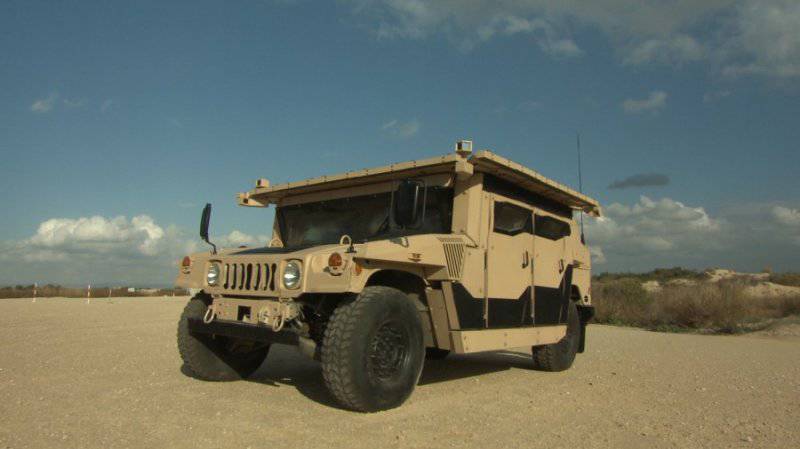
KAZ Trophy-LV was developed in response to the need to protect light cars
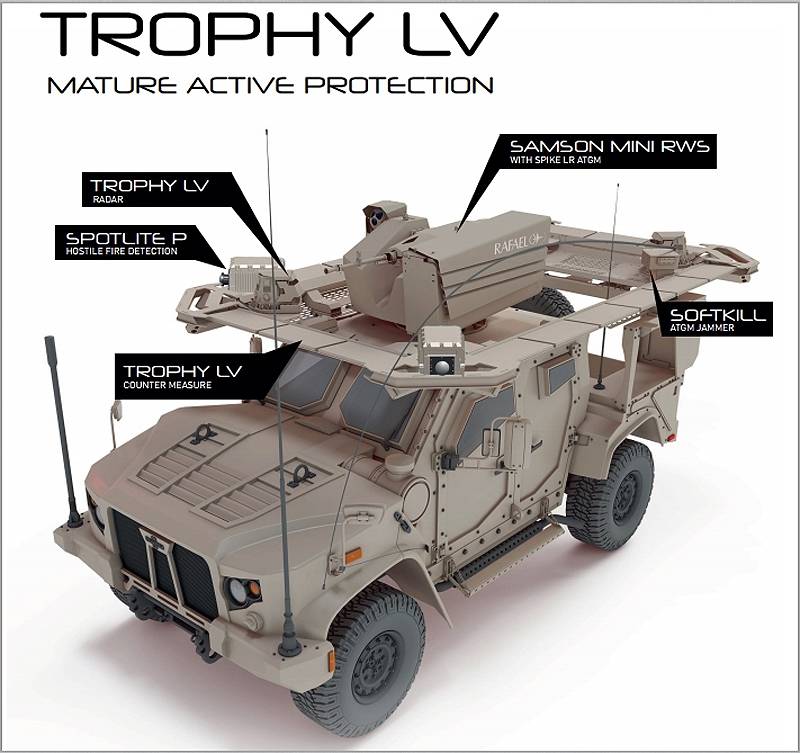
Installation scheme of the Trophy LV system on the Oshkosh M-ATV armored car
Sugar added that “in fact, this is the same KAZ Trophy, which is installed on Merkava, Namer and Abrams, but at the same time it weighs less on 300 kg and takes up less volume on 30% so that you can install it on DUMV or on such machines like ASCOD, Ajax or heavy 8x8 BTR. "
The capabilities of the MV variant are the same as those of the MV, the radars of both variants have the same detection and classification characteristics of the attacking threats. “Trophy MV appeared today in order to fill the upcoming period in 3-4 of the year when we are ready to present the next generation complex,” said Sugar.
Reign on the battlefield
In addition to the Trophy, the US Army is also considering two more systems, the Iron Fist and the Iron Curtain, which will be installed on the Bradley infantry fighting vehicle and the Stryker BTR respectively. The Iron Fist system, developed by IMI Systems, is designed for installation on a wide variety of vehicles, starting with the HMMWV armored car and ending with medium-sized armored personnel carriers and heavy OBTs. It can fight such threats on the battlefield as anti-tank unguided missiles, anti-tank guided missiles and anti-tank anti-tank missiles.
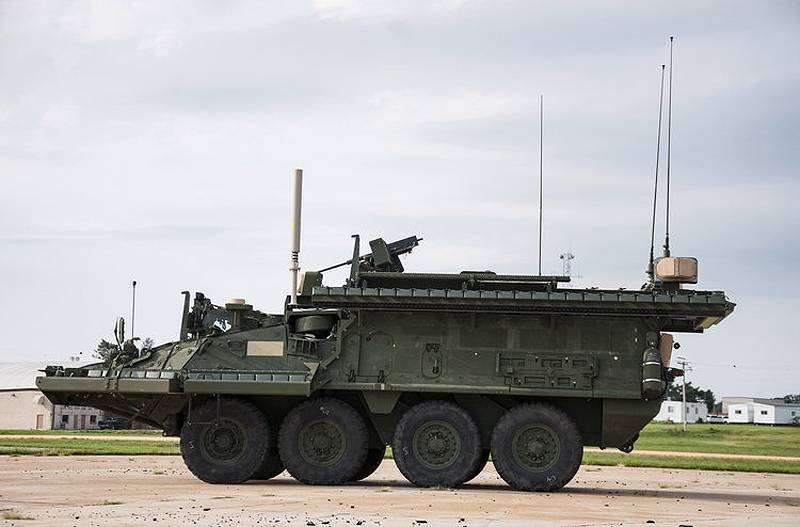
Iron Curtain Active Protection System on Stryker armored vehicle
In December 2016 of the year, it was announced that the Dutch army would install Iron Fist systems on its CV9035 armored vehicles from BAE Systems. The CV90 with two Iron Fist launchers covering the left and right sectors was shown at DSEI 2017.
This technology includes 4 level: the level of real-time situational awareness on the basis of a set of radar and opto-electronic sensors; the level of opto-electronic suppression based on a directional optocoupler of interference to combat anti-tank missile; the level of direct destruction of targets with the ability to intercept threats using an explosive strike element at a safe distance from the protected platform; and the fourth level is the ability to counterattack on the basis of data from system sensors, which allow you to accurately hit the emerging threats.
Iron Curtain from Artis, just like Iron Fist and Trophy, can be installed on any ground platform plus on helicopters, boats and fixed structures, such as buildings. The system provides protection against jet grenades and other manual systems. It uses high-speed detection and parallel data processing technologies to intercept and destroy threats several tens of centimeters from the target, which allows minimizing indirect damage. In addition, the lightweight system occupies a very small volume.
Ultimately, we are moving in the direction of the so-called "holistic protection" and move away from existing solutions that increase the mass and power consumption of the platforms. For this purpose, sensors that perform different work (if possible independently) could be involved, which increases the uniformity and reduces the level of complexity of the system. As one of the possible directions, it would be possible to use detection technologies not only for detecting and neutralizing threats, but also as a surveillance tool that expands the capabilities of the crew of the vehicle.
“Everyone wants to shoot down a rocket grenade, not a question, but I think many combat commanders consider this a bonus. - explained O'Leary. - Still, it would be more important from a tactical or even from a strategic point of view to have combat platforms at the forefront that learn about the threat even before the attack or immediately at the moment of its beginning. Embedding in this decision-making cycle, the ability to respond with fire before the threat hits you, will have a huge impact on the operational thinking of our units. ”
On the materials of the sites:
www.nationaldefensemagazine.org
www.thalesgroup.com
www.lacroix-defense.com
bumar.gliwice.pl
www.leonardocompany.com
www.rafael.co.il
www.army.mil
artisllc.com
www.imisystems.com
www.alamy.com
aw.my.com
www.popmech.ru
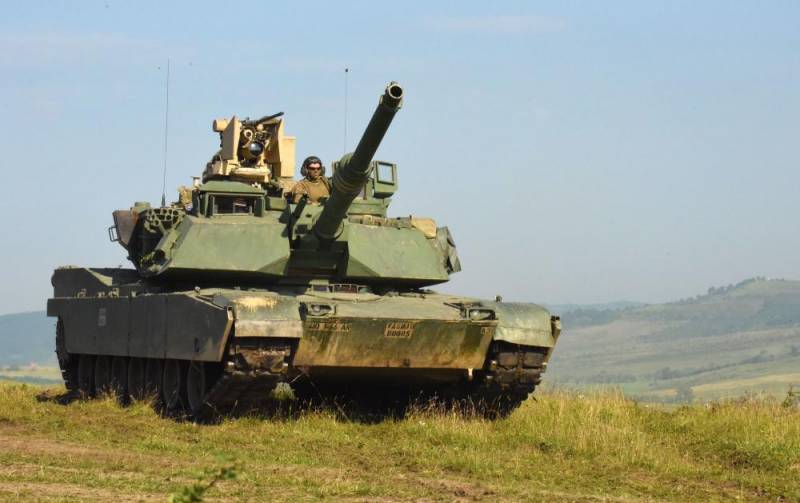
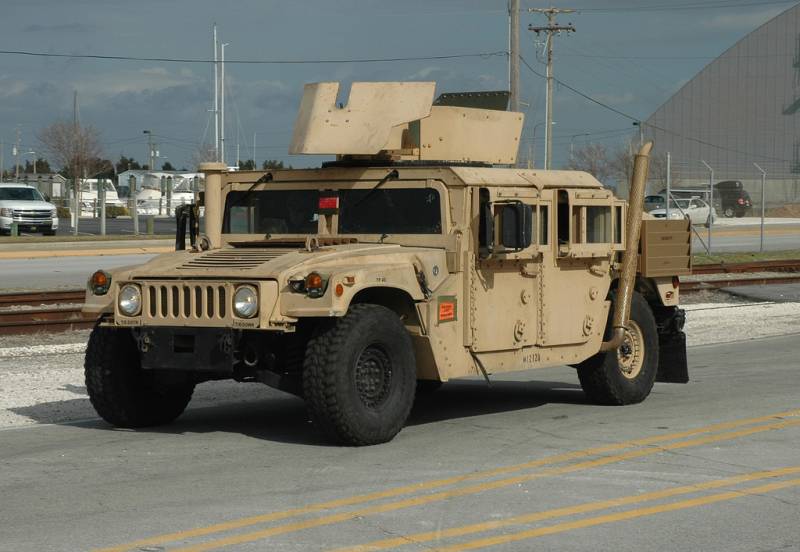
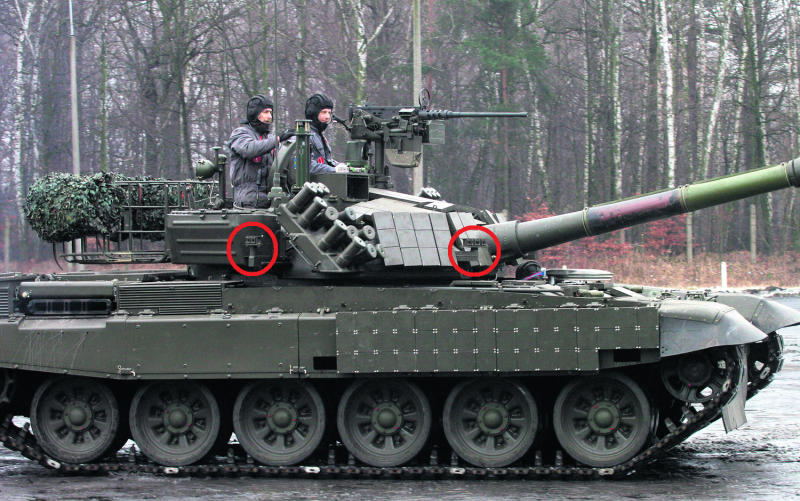
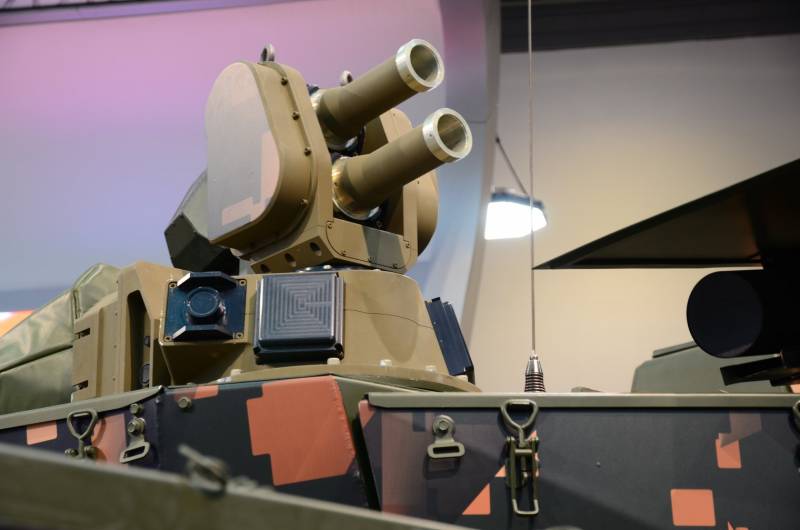
Information